Sugar in Yogurt: Navigating the Yogurt Aisle
This post may contain affiliate links. As an Amazon Associate, I earn from qualifying purchases. Please read my disclosure.A complete guide to sugar in yogurt to help you find the best, healthy yogurt option for you. Which brands are the best, and which to avoid!

Greek. Icelandic. Swiss. Fruit flavored. Fruit at the bottom. Nonfat. Lowfat. Full-fat. Soy yogurt. Almond yogurt. Sheep’s milk. Goat’s milk. Organic. All-Natural.
Have you ever stood in front of the yogurt aisle just completely overwhelmed by all of the choices?
I definitely have!
Once upon a time, yogurt was probably limited to plain or vanilla, with maybe a couple of brands to choose from. Today, the yogurt aisle is staggeringly long, with what seems like hundreds of different choices, brands, flavors, and textures — all of which claim to be “healthy.”
And of course, yogurt is a healthier choice for a snack than, say, a can of soda (although some yogurts, with the amount of sugar in them, come pretty close to that can of soda!)
But because it can be SO confusing, I thought I’d create this guide to help you navigate the yogurt aisle – with my tips and tricks for figuring out which yogurt is right for you, and a list of my favorite brands!
Why Is Yogurt Good For You?
- It’s a decent source of vegetarian protein that’s low in calories.
- It is a good source of calcium.
- It contains good-for-you bacteria – known as “probiotics” or “live and active cultures” that can help improve digestion and regulate your immune system.
- It contains Vitamin D (which helps boost calcium absorption).
- And it tastes good!

Why Are Some Yogurts Bad For You?
Not all yogurt is good for you! I know that may come as a shock. But most of the yogurts that are on grocery store shelves, are not a health food, even though their packaging claim otherwise.
- Most yogurts are high in sugar. All yogurt has some natural occurring sugars, but most have added sugars in the form of fruit on the bottom, fruit mixed in, added ingredients such as chocolate chips, or cookies (flip yogurts), etc. While the natural occurring sugars are okay for you, the added sugars are enough for your daily recommended 24 grams or less. For example, Dannon Fruit on the Bottom yogurts can have as many as 24 grams of sugar per serving.
- Artificial sweeteners are also commonly found in yogurt. Studies have shown that artificial sweeteners can raise blood sugar levels, insulin levels, and may cause type 2 diabetes. They are 200 to 600 times sweeter than regular sugar. They can effect your hormone levels, and slow your metabolism.
- Both sugar and artificial sugars are addictive. The more you have them the more you desire to have more. Eating sweetened yogurts can cause you to crave more sweets throughout the day.
Why Should You Care About Sugar In Yogurt?
I know there are so many things to think about when it comes to eating healthy, that one more thing, like the sugar in your favorite yogurt, might seem like something that’s really not all that important. However, you can easily go over your total amount of recommended added sugars in a day, by just eating your one favorite yogurt. Women are recommended to consume no more than 25 grams of added sugar, and men are recommended to consume no more than 33 grams of sugar. Excessive sugar intake is associated with obesity, cardiovascular disease, and other chronic health conditions.
How Can You Tell How Much Added Sugar is in Your Yogurt?
When you take a look at the nutrition label of your favorite yogurt you’ll see “total sugars” and below that there should be a label that tells you how much is added sugar.
For example a 4 oz raspberry yogurt has 16 grams of total sugar with 12 grams of added sugars. Therefore, 4 grams of sugar is naturally occurring from the milk, but 12 grams is added in the form of cane sugar.
If you want to know how many teaspoons of sugar is in your yogurt, divide the grams my 4. So, in the example above there are 3 teaspoons of added sugar, and 1 teaspoon of natural sugar.
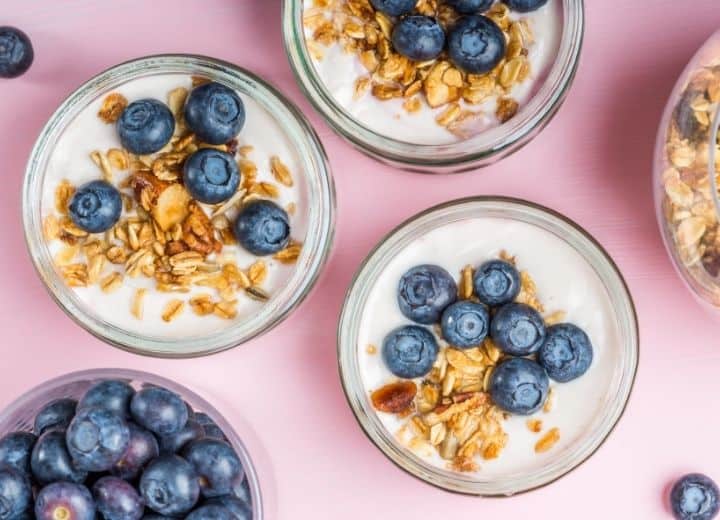
6 Rules For Buying Healthy Yogurt
1. Protein Content: Keeps you fuller longer. For a true protein punch, try Greek Yogurt. Since it is strained, it requires three to four times more milk to produce than regular yogurt, which adds up to 15g to 20g more protein per 6 ounces – equivalent to 3 ounces of meat! (Regular yogurt has about 9g protein for 6 oz.)
2. Live Active Yogurt Cultures (i.e. healthy bacteria): The FDA requires at least two strains of bacteria in all yogurt, L. bulgaricus and S. thermophilus. Yogurt makers can add more. Look for the National Yogurt Association seal: It ensures 100 million cultures per gram (i.e., lots) – (source: CookingLight.com)
3. Limited added sugar in yogurt! This one is incredibly important. 6 oz of plain, unsweetened yogurt have about 6-10 oz of naturally occurring sugars from the milk. Fruit, honey, and sugars add more. Some yogurts (especially those made for kids) can have as much as 20-30g of sugar! That’s more than one can of Coke. Stick to unsweetened flavors, and add your own natural sweeteners (like fresh fruit or 1 tsp of honey) if needed.
4. Fat content: Low-fat yogurts are the best because they have a tiny bit of fat to help absorb the protein and vitamins in the yogurt, but they also have more calcium. When fat is removed, calcium gets concentrated. Lower fat yogurts have about 30% of your recommended daily intake. Greek yogurts have 20% (because some calcium is removed through the straining process). Choose low fat over non fat.
5. Organic / no rBGH (growth hormone): Dairy cows are routinely fed hormones, antibiotics, and pesticide-covered grains, all of which can end up with trace amounts in your milk and your yogurt! Buy organic with no hormones and you’ll be good to go.
6. No fillers or thickeners (i.e. cornstarch, gelatin, pectin or carrageenan): Fillers and thickeners are often added to non-dairy yogurts to give them stability and a good consistency, but they are also highly processed ingredients that may trigger digestive issues and inflammatory reactions in the body.

What Are The Healthiest Yogurt Brands? (How to Avoid Sugar in Yogurt)
Wallaby Organic Low Fat Greek Yogurt and Stonyfield Farms: Organic, Plain, Low Fat Greek Yogurt are my two favorites! I add fresh blueberries, 1/2 tsp honey, and a handful of walnuts to it.
Other Favorite Low Sugar Yogurts:
- StonyField Farms Organic Plain Regular or Greek Yogurt
- Wallaby Organic Plain Regular or Greek Yogurt
- Trader Joe’s Organic Low Fat Plain Regular Yogurt
- Chobani Plain 0% Greek Yogurt
- Fage Total 2% Greek Yogurt
- Dannon Oikos Plain 0% Greek Yogurt
- Siggi’s Icelandic Plain Yogurt
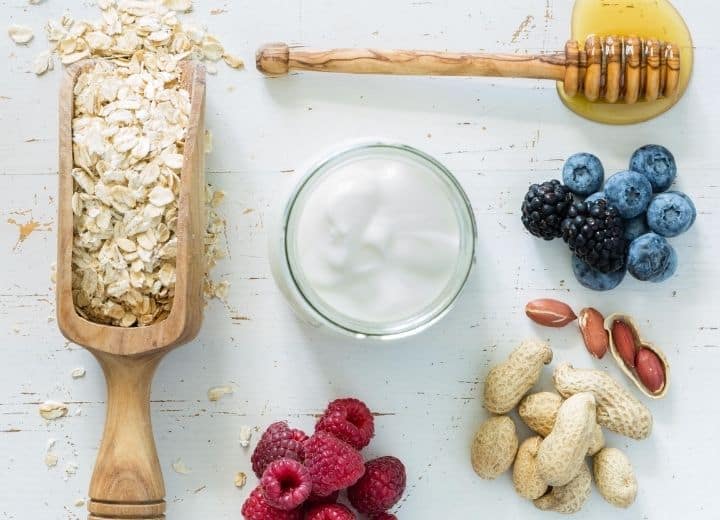
How To Make Your Own Healthy Yogurt?
If you love fruity yogurt, but want to stay away from all that added sugar, here is a quick recipe for making a sweet yogurt that has almost no added sugar:
- Buy plain low-fat yogurt.
- Add two handfuls of fresh berries or fruit. Blueberries, strawberries, raspberries, etc.
- Add 1-2 tablespoons of chopped nuts on top for added crunch and healthy fats.
- If you need a bit of sweetener, add 1 tsp of honey.
- Optional: Add 1 handful of your favorite low sugar cereal
- Mix together and enjoy!
What if you’re on the go and can’t add your favorite fruit to your yogurt?
If you want a flavored yogurt (e.g. you’re on the go and can’t add fresh fruit, a dash of honey or vanilla), choose one flavored with vanilla or honey – but watch out for the sugar content! Siggi’s Icelandic yogurt has one of the lower sugar contents for flavored yogurt – so that can be a good choice as well – but the texture of Icelandic yogurt is not for everyone so try it out and see how you like it before buying a ton of it!
Sugar in Yogurt: What Are The Worst Yogurts To Buy?
The absolute words yogurts you can buy based on the grams of sugar, include yogurts with fruit on the bottom, ones that have flips, where you add extra sweetened ingredients into the yogurt.
The words yogurts based on added sugars.
- Fage Split Cup Honey, 29 grams
- Wallaby Aussie Greek Honey, 28 grams
- Noosa Caramel Chocolate Pecan, 27 grams
- Dannon Fruit on the Bottom Yogurts (Blueberry, strawberry, peach, cherry, raspberry, and strawberry banana), 24 grams
- Fage Crossovers Coconut with Dark Chocolate, 23 grams
- Dannon Lowfat Yogurt Coffee Flavor, 22 grams
- Chobani Flip Peanut Butter Dream, 22 grams
- Yoplait Whips Peanut Butter Chocolate Girl Scouts, 22 grams
- Yoplait, Mix-Ins Coconut Chocolate Almond, 22 grams
- Dannon Oikos Blueberry Greek Yogurt, 19 grams
- Yoplait Greek Blueberry Yogurt, 18 grams
- Yoplait Original Strawberry Yogurt, 18 grams
- Chobaini Fruit on the Bottom Blueberry Greek Yogurt, 15 grams
I hope this post has been helpful for your next trip to the grocery store!
Check Out These Other Helpful Healthy Eating Guides!
- Best Protein Powders for Women
- Best Protein Powders for Kids
- Healthy Cereal for Breakfast
- How to Find the Healthiest Store Bought Bread
- 15 Pantry Meals You Can Make in 30 Minutes
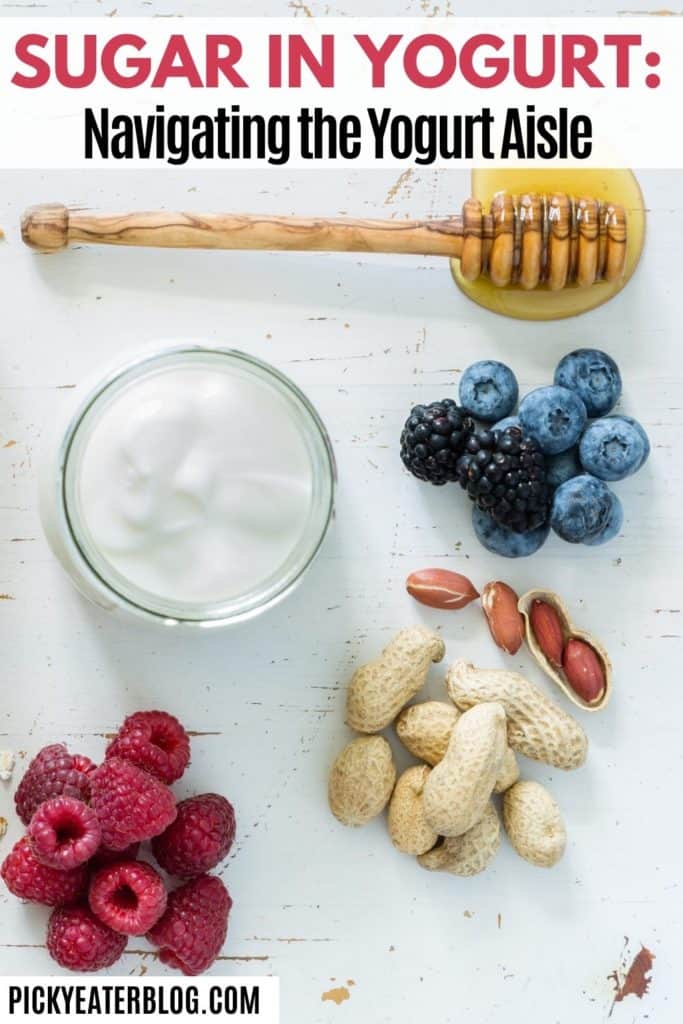













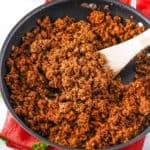


















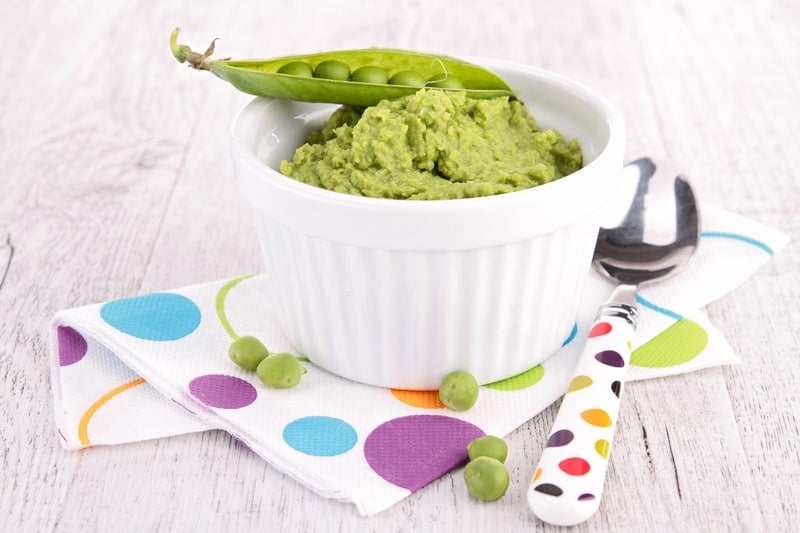




Hi, I am wondering about how many of the live cultures in store bought, flavored or plain, are still alive by the time we purchase and consume it? I understand that a certain amount of millions or billions are there at time of manufacture but how many are still there when we buy it?
Hi Donna, this is a great question! If the yogurt isn’t heat-treated, then generally the same amount of live and active cultures that were there at the time of manufacture are still there when you purchase the yogurt. If you are buying a yogurt with the “live and active cultures” seal, then you can assume that the yogurt has 100 million cultures per gram of yogurt. Hope that helps!
Hi,
I’m having a hard time finding a nonfat, or lowfat, organic , almond yogurt.
Do you know of any?
The yogurt aisle is like a rubrics cube. Some have one but not the other, fustrating!
Thanks
Hi Dianna! Honestly, most of the time I don’t recommend Almond Yogurt as a 1:1 replacement for regular yogurt because it often has almost zero protein and a ton of sugar — so it’s mostly just empty calories (with some probiotics). I actually haven’t found any brands of organic almond yogurt in the store at all — but one brand that is non-organic that I’ve found that looks pretty nutritious (thanks to the pea protein and no added sugar) is this: https://sodeliciousdairyfree.com/products/cultured-almond-milk/plain-greek-cultured-almond-milk. You can also try making your own at home – that way you can buy organic almonds and control the rest of the ingredients too.
I hope that helps! Let me know if you have any other questions!
Like so many of you, I stood in front of the aisle of yogurt, reading the labels in amazement that the manufacturer can claim that their product is ‘natural’ and yet it contains items like frutrose and artificial ingredients. Sadly, the only way one can get healthy yogurt or foods in General is by simply making from scratch yourself. Because profit is the main drive with manufacturers, offering a truly healthy product takes a back seat. So sad for those that purchase commercial yogurt with the idea of eating healthy. Read the labels!
Hi Dennise! I agree with you that label reading is key to figuring out which products are actually healthy vs. not. But there are definitely yogurt brands out there that are 100% organic and only have 1 ingredient! Reading labels will help to find those brands among all of the rest of the “fake healthy” yogurts out there!
Is there such thing as unsweetened yogurt? That is, yogurt with 0 grams of sugar. If so, what is the brand? If not, which brand of yogurt has the fewest grams of sugar?
Thanks for any suggestions!
Hi Pat! That’s a great question. So technically, the answer to your question is no. This is because yogurt is made from milk, and milk has naturally occurring sugar in it (lactose is a sugar). Therefore, all yogurt will have some sugar in it because of the lactose. Plain, unsweetened yogurt will still have 4-10g of sugar (depending on whether the yogurt is Greek yogurt or regular and how big the container is). You won’t be able to find a yogurt with 0g of sugar, the same way you won’t be able to find milk with 0g of sugar. But that’s ok! The naturally occurring sugars in yogurt and milk are healthy and completely fine to have – as long as you don’t have trouble digesting lactose. The key is to just get plain yogurt instead of the flavored varieties – to avoid added sugars. I hope that helps! Let me know if you have any other questions!
Thanks so much! That answers my question perfectly.
Pat
Oh good! I’m glad it was helpful!
I enjoy your blog. Confusion is over I have my top 2. Thanks for that. I like the idea of the raw oats. Saw the idea of over night soaking oats in plain yogurt. I try adding 1/2 to 3/4 the yogurt amount which is an enjoyable thickest for me. Ingredients for yogurt sounds nice.
Thanks so much Jim! And yes – soaking oats overnight in plain yogurt is absolutely delicious! You can also add nuts or fresh fruit to it in the morning for a nutritious, balanced breakfast.
I was wondering if you have recommendations for lactose free yogurt, I can’t do too many dairy products because it doesn’t agree with my stomach.
Hi Brittney! I think Green Galley Organics makes a wonderful line of all-natural lactose-free yogurts. Additionally, Greek Yogurt contains far less lactose than traditional yogurts. The process of making Greek Yogurt filters out most of the whey which is where lactose is found. So depending on how much lactose bothers you, you might still be able to eat regular Greek Yogurt! Hope that helps!
Greek yogurt is practically a food group for me! I always buy zero percent and add sliced almonds or almond butter and fresh fruit. I recently went to the chobani store in nyc and had the combo with cucumber, dill, olive oil and pita chips on the side- it was awesome! I have since made my own versions of that for snacks often.
Oh YUM!! Chobani + cucumber, dill, olive oil and pita chips?? That sounds amazing! You have just inspired my snack for tomorrow 🙂 Thanks so much!
this is awesome! yogurt world is just insane with so many choices leaves me more confused than ever. I try to just stick unsweetened low fat organic stuff as much as i can..flavoring with cinnamon or honey is a good option too 🙂
Yes I totally agree!! It can be super confusing! Ooh I love the idea of flavoring with cinnamon – I haven’t tried that yet but that is now on my list! 🙂
What a great article you have there. I didn’t realise how many benefits yogurt contained, it especially surprised me when you said yogurt contained Vitamin D. Also I think it would be an interesting blog if you talk about different ingredients to add to yogurt, what are the healthier options, and what is a filling option to add.
Thanks Kimberley! I’m so glad you found this post helpful! And yes! Absolutely – I’d be happy to do a post about ingredients to add to yogurt — but off the top of my head here are my favorites:
– 1 Tbsp granola + fresh blueberries
– 1 Tbsp almond butter + 1 tsp strawberry preserves
– 1/2 cup of high fiber cereal + fresh fruit
– You can season Greek yogurt with herbs and make it a “dip” for carrot sticks/celery sticks/other veggies
– You can also use Greek yogurt as a substitute for sour cream in Mexican food
Hope that helps!
I found this blog very interesting!
My family and I are very much into healthy eating as my bro does bodybuilding, however I have always gotten pretty bored with snack foods such as nuts and turkey etc.
I started getting into yogurt about the last month for a good snack, I go for the brand ‘dairy farmers’ I found out this is low in sugar and fat! I usually put coconut in mine to give it extra flavour or oats.
My next step is trying to find a yogurt that is organic, if anyone has a good brand name that I can go for that is low in sugar, fat and is organic please let me know.
thanks.
Thank you so much Gina! I’m so glad you enjoyed this post. I love the idea of adding coconut or oats to your yogurt – I bet it gives it a “muesli-like” flavor! I’m not sure what’s available in your grocery store, but I like Stonyfield and Chobani for low sugar, low fat, organic yogurts. Hope that helps!
I like So Delicious Coconut Milk Yogurt. My stomach can’t handle cow’s milk so when I found this yogurt I had to try it. It is really good and a great way to have yogurt if you love it but your stomach doesn’t!!
I’ve never tried Coconut Milk Yogurt before but it sounds delicious! Thanks for the tip Jen!
Want even more protein in your yogurt? Add a teaspoon of peanut butter in a plain or vanilla yogurt. It’s really good. Shocked the companies haven’t created this flavor yet
Oh woah! I’ve never tried that before — that sounds so interesting! I wonder if ends up tasting like peanut butter ice cream (which is delicious). Thanks for sharing Doug!
Anjali,
You have to try Noosa! They only make flavored yogurts at the moment, but it’s the flavor of the yogurt itself that is yummy. I usually leave aside the fruit, or just eat a little with the yogurt.
Texture too is amazing, very creamy.
Oh interesting! I’ve never heard of them before. I’ll have to check them out once they start making a plain/unsweetened kind! 🙂
I just spent a good 20 mins in the yogurt aisle on Sunday afternoon. I just kinda got…drawn in by all the flavors and brands. I ended up with enough yogurt for about 5 months! I just couldn’t decide!
Oh my gosh I know exactly what you mean! All of the variety can be really attractive 🙂 Hopefully you ended up with some brands and types that you enjoy! You’ll have to keep me posted on which one you like the best!
Stonyfield and Chobani are my go-to’s but I also love Fage
That’s great! It sounds like we have the exact same taste in yogurt 🙂 Thanks for sharing Lynn!
Do you think it is better to buy Honey Chobani or Plain Chobani and add 1 tsp of raspberry jam? I started to do the raspberry jam and with a handful of grape nuts added and veggies on the side, it makes a perfect lunch!
Thanks so much for this post, I have been overwhelmed many times!
Thanks so much T! I’m so glad you found this post helpful. To your question – I’d recommend buying Plain Chobani and adding 1 tsp of jam. You will end up with way less sugar than the already-sweetened Honey Chobani flavor. Love your idea for lunch btw – it sounds light and delicious!
wow u read my mind….i exactly do what u said when i stood in yogurt aisle reading contents, facts etc….
this is a really helpful post anjali..thanks….I usually like Chobani greek yogurt with fruit as they r rich in protein but they too contain some 26gms of sugar which scares me sometimes …but i cant eat unsweetened…its too strong for me…i usually make Curd at home in Indian style and add fresh fruits…..
Aw thank you so much Jo! And yes, you are right – the sweetened yogurts contain WAY too much sugar. It sounds like you’ve found a nice balance with making yogurt at home and adding in your own fresh fruit! That is really the way to go. You can even add a dash of honey or some granola to your yogurt to sweeten it up naturally — without end up with 26g sugar in the yogurt.
No lie, I spent 10 minutes in front of the yogurt last night at the grocery store. In fairness, I went to the big HEB, which I rarely do, but still. I typically go for the Dannon Oikos, but they were out of the plain last night.
I ended up with StonyField and Chobani (figured why not try something new), so we’ll see. I can’t eat yogurt day in and day out, but I can usually go one week eating it for breakfast or snack. Then I have to change it up.
Haha! I totally know what you mean Jen – I have literally spent 15 minutes in the yogurt aisle at times trying to figure out what brand/type to buy. Sounds like you ended up with some good brands though – I love both Stonyfield and Chobani. Another way to use yogurt is to add it into smoothies — that way you don’t have the monotony of eating the same thing every day. Hope that helps!
Another way to get around all the confusion in the yogurt isle is to just make your own from organic milk. It’s guaranteed healthier since you know what’s in it, and a typical yogurt maker (for if you don’t have the right conditions in your house) pays for itself after about 20 uses. If you want Greek-style yogurt you can strain it in cheesecloth and use the whey in smoothies or bread baking.
That is a great tip Magdalen! I love how many people make yogurt from scratch at home – you are inspiring me to give it a try! 🙂
I make my own! So much healthier and so easy! Most store bought yogurts are not fermented long enough to have the essential probiotics form. And most add a ton of sugar and other chemicals. Fat actually is the least concern of mine – it is the sugar and other crap they add to it. Making it yourself and adding Stevia or raw, unpasteurized honey or other fruit is the best 🙂
Wow!! That’s so awesome Kim! I’d love to make my own yogurt at home. And yes – homemade is definitely the best kind if you are able to do that. And I’m totally with you – sugar and the added stabilizers/chemicals/hormones are my main concern as well (versus fat). I actually love whole milk yogurt! But for folks who are watching their weight or just want a lower fat option – low fat yogurt is really good too, as long as it’s not highly processed 🙂 Thanks for sharing your thoughts – and you’ll have to send me your homemade yogurt recipe when you get a chance!